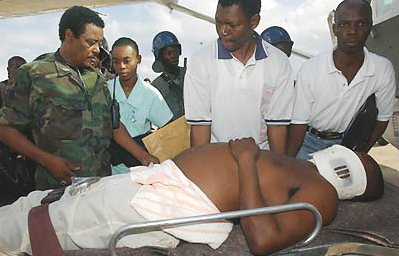
Ten years ago I joined the staff of the Committee to Protect Journalists to launch the Journalist Assistance program, an initiative, as CPJ board member Gene Roberts describes, developed to establish a standing direct response mechanism for journalists facing threats and attacks. When I left the position in 2009, many people asked me what case stood out the most.
It’s not an easy question to answer. In the eight years I served as the program’s coordinator I had the privilege of working on more than 300 cases. I helped journalists who needed to go into hiding or exile because of threats against their lives. I arranged for them to receive medical treatment following brutal attacks, or basic support while they were in prison. So many individuals remain in my thoughts for their courage, professional commitment, and indomitable spirits. Some have allowed me into their lives and families. But there is perhaps one case that most often comes to mind when I talk about CPJ’s assistance work.
In 2004, amid growing civil unrest that culminated in then-Haitian President Jean-Bertrand Aristide’s ouster, CPJ received an urgent call from our colleagues in Port-au-Prince. Radio journalist Pierre Elisem was in critical condition after armed men shot him in the neck, leaving him for dead. As rebel groups encroached on Port-au-Prince, curfews, frequent electrical shortages and lack of supplies meant Elisem, paralyzed and fighting massive infections from his injuries, might not survive if he wasn’t evacuated.
The next few days turned into a frantic scramble of calls to hospitals, colleagues, partner groups, and medevac companies to find a way to get him to a facility that could accept him in his condition, with no insurance, not to mention someone willing to fly into the capital in the middle of a rebel takeover. Funds far more substantial than CPJ’s distress fund could provide had to be raised virtually overnight–while coordinating with colleagues on the ground working to secure transport to the airport through the roadblocks and fighting that was spreading through the city’s streets.
Against all odds, the plan came together. Elisem was safely transported to the Dominican Republic, where he received weeks of treatment in a clinic, followed by several months of outpatient physical rehab treatment. Slowly, he regained his ability to walk.
Elisem’s case remains strong in my memory certainly because of its urgency–it was a true life-or-death situation–and because of the large scale of assistance. Elisem himself, a feisty, resilient character (he’s a mile-a-minute talker, even when lying immobile in a hospital bed) is unforgettable. But more so because it embodies to me many of the complexities of CPJ’s assistance work, its rewards and challenges.
Firstly, as is often the case, Elisem’s rescue would not have been possible without the fast and generous responses of CPJ’s partners and supporters. In two days we secured commitments totalling $20,000 from a dozen parties including groups that would later form the Journalists in Distress network, journalists in Haiti who made commitments and organized fundraising on the ground despite the tumultuous conditions, and the Inter-American Press Association, which not only contributed but used their contacts to get him admitted to a top clinic in Santo Domingo.
While funding his evacuation and treatment was a big piece of the puzzle, just as important was the enormous job of lining up the necessary resources and services all while troubleshooting and problem-solving along the way. Even after Elisem received urgent medical care, CPJ sent me to the Dominican Republic to help with his post-discharge needs–everything from renting a wheelchair to securing a temporary apartment.
What lingers with me in this case is that his story and struggles did not end with his exit from critical care. Elisem then had to cope with painful physical rehab process. He has recovered much of his mobility, despite initial fears he might be paralyzed for life, but full movement has been difficult and painful.
Shortly after his arrival in DR, Elisem had to grapple with questions about his security if he were to return to Haiti, where his attackers remained at large. Months later, he moved on to Miami and received asylum in the United States. Jobless, still in recovery, and far from his close-knit family, it would be years before his situation stabilized. He still lives in the Miami area and broadcasts from a local station.
In many ways, his is an incredible success story, but knowing the painful, difficult road Elisem has travelled, the physical and professional hurdles he still faces today and the emotional toll of living in exile has led me all too often to question whether we made the right choices. Could we, should we, have done something differently? Should we have done more, even at the expense of other journalists in need of our resources? These questions have no easy answers but asking them over the years about Elisem and others has made the program–which, with a new team in place has helped nearly 100 journalists in the last six months alone–stronger, better informed, and ready to help others.
This entry is part of a series commemorating 10 years of CPJ’s Journalist Assistance program.
